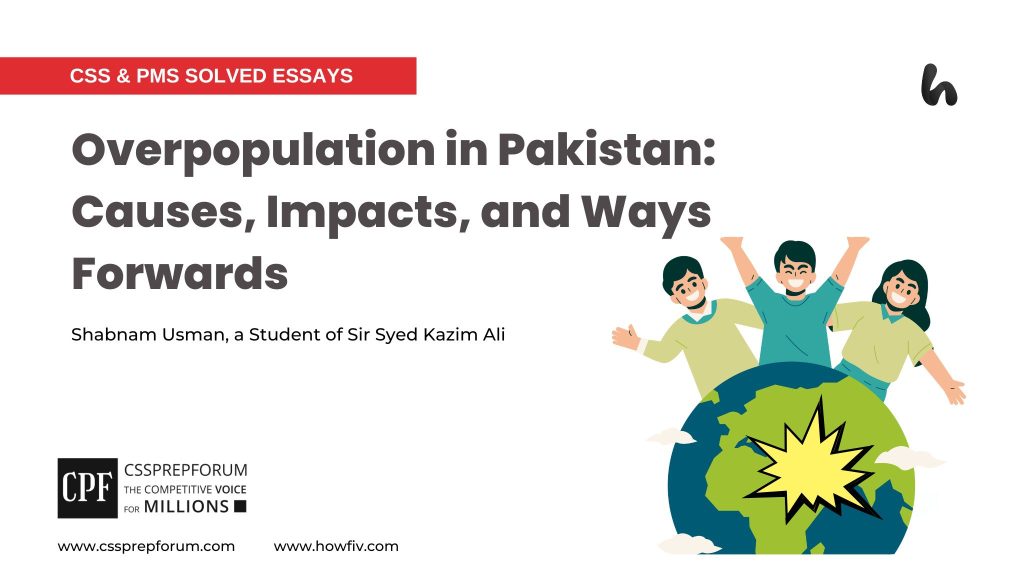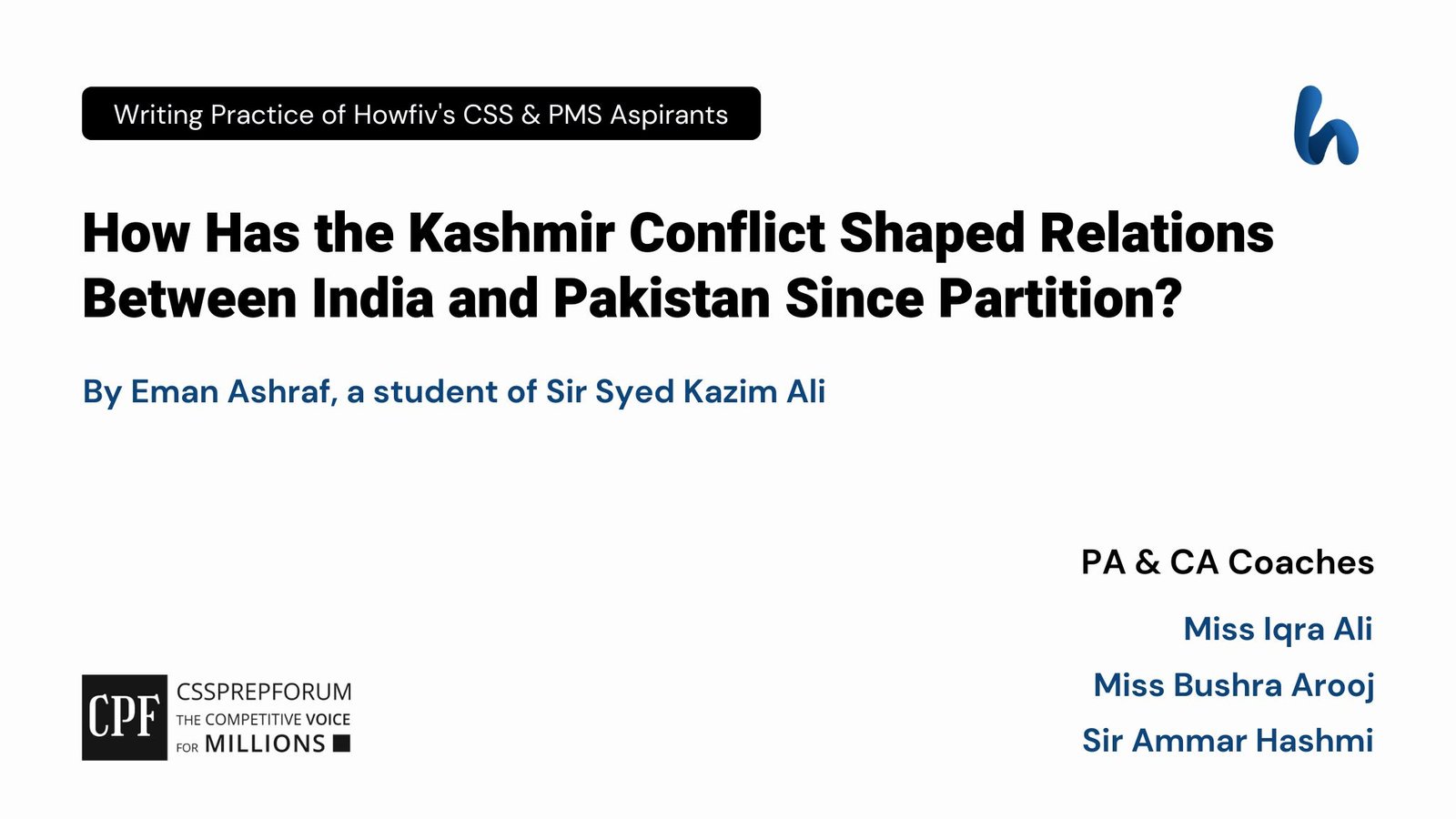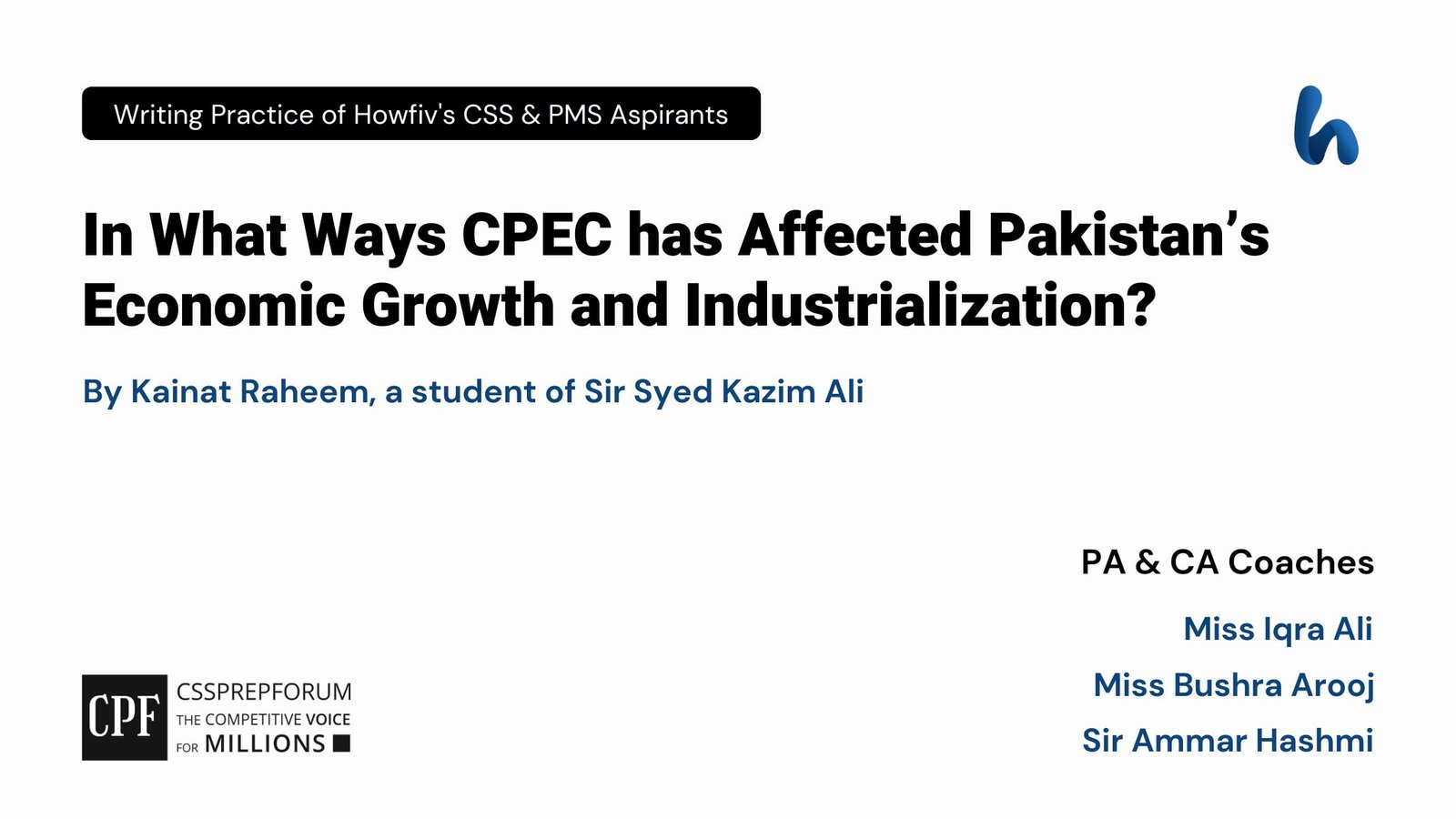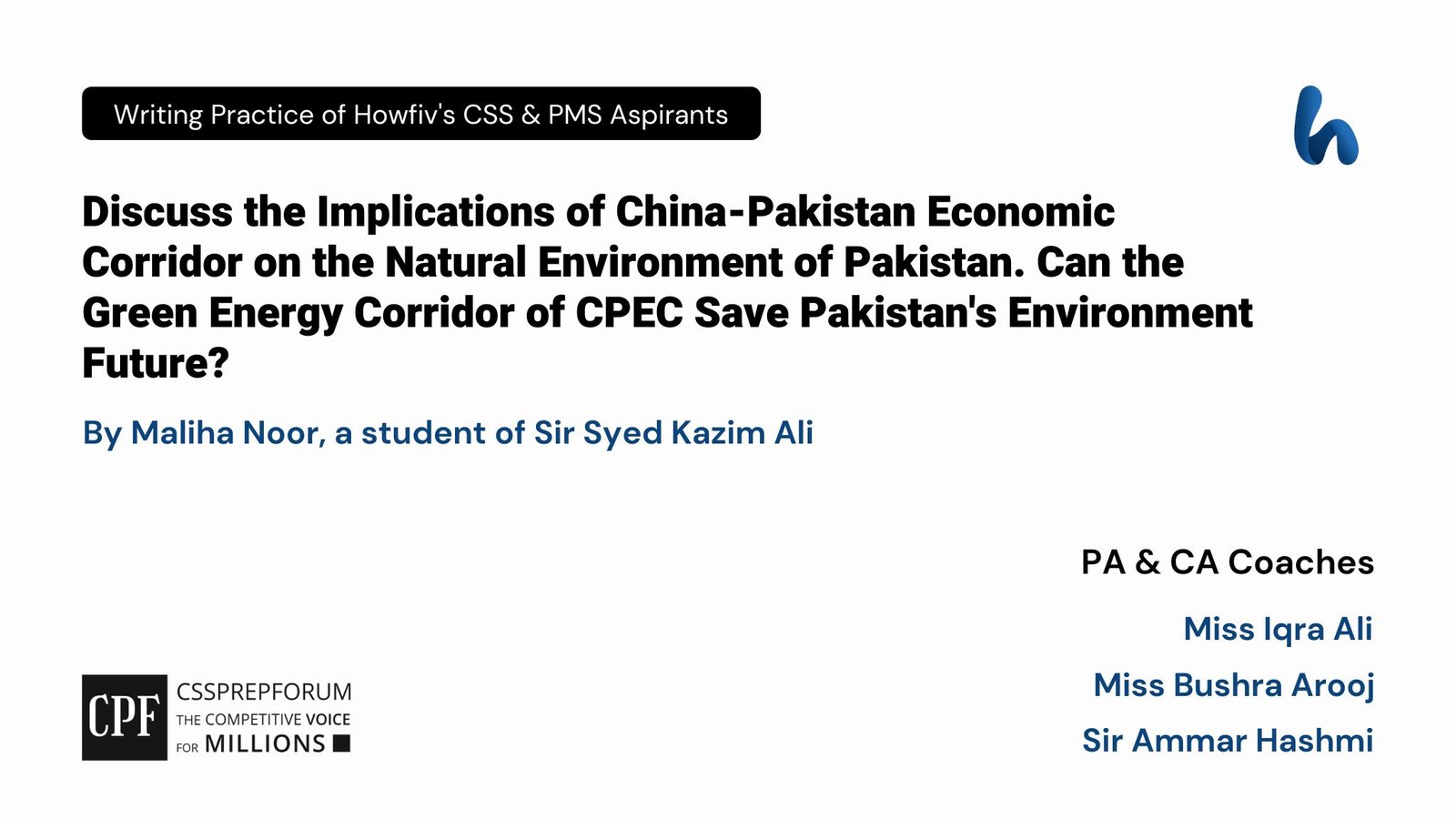Shabnam Usman, a Sir Syed Kazim Ali student, has attempted the CSS essay “Overpopulation in Pakistan: Causes, Impacts, and Ways Forwards” on the given pattern, which Sir Syed Kazim Ali teaches his students. Sir Syed Kazim Ali has been Pakistan’s top English writing and CSS, PMS essay and precis coach with the highest success rate of his students. The essay is uploaded to help other competitive aspirants learn and practice essay writing techniques and patterns to qualify for the essay paper.

Outline
1- Introduction
2- Overview of the Current Statistics of Population in Pakistan
3- Causes Responsible for Population Expansion in Pakistan
- ✓Low literacy rate in the community
- Evidence: The World Bank Report 2019 indicates that corresponding to literacy rates, “Pakistan has scored 7th out of eight South Asian countries; conversely, the country has the highest population growth rate in the region.”
- ✓Religious conservatism of ulemas
- Evidence: The so-called religious scholars propagate ‘quantity’ as a matrix of growth for the Muslim Ummah
- ✓Culture of early marriages and polygamy
- Evidence: According to the United Nations Report on Child Marriages, 2020, “Pakistan has ranked sixth in the girls’ highest number of girls who were married before the age of 18.”
- ✓Patriarchal patterns of society
- Evidence: According to the Gender Development Index 2021-2022 (the United Nations Development Program (UNDP), “Pakistan has showcased a ‘low human development’ ratio.”
- ✓Poor economic plight of people
- Evidence: The United Nations Development Programme (UNDP) Report, 2022 finds that the world’s regions – Africa and South Asia – having low per capita income share the characteristics of large population and high population growth rate
- ✓High refugee influx
- Evidence: According to the United Nations High Commissioner for Refugees (UNHCR) Report, 2023, “Pakistan has hosted 2.1 million refugees.”
4- Impacts of Ruthless Population Growth in Pakistan
- ✓Increased food insecurity and stressed resources
- Evidence: The government had to import wheat worth $ 2 billion in 2022.
- ✓Escalated environmental degradation
- Evidence: “Pakistan has been spotted at 176 on the Environmental Performance Index, 2022,” a joint report produced by Yale University and Colombia University
- ✓Compelled people to adopt poor living standard
- Evidence: The Human Development Index, 2022, has placed Pakistan in the 161 position
- ✓Raised municipality management issues
- Evidence: “In Pakistan, city authorities still need to achieve a consistent, integrated, and harmonious urban built form despite spending billions on public infrastructure, thus leaving the cityscape muddled.” (Pakistan Institute of Economic Development (PIDE)
- ✓Declined economic growth
- Evidence: “The current gross domestic product (GDP) growth rate remained 0.29% for the fiscal year 2022-23,” as per the statistics of the Economic Survey of Pakistan, 2023
- ✓Triggered law and order crisis
- Evidence: According to the Pakistan Bureau of Statistics Report, 2020, “The number of all reported crimes has increased from 0.64 million in 2010 to 0.87 million in 2020; likewise, its population figures were 194.5 million in 2010 and 227.2 in 2020.”
5- Solutions to Manage the Overpopulation Disaster in Pakistan
- ✓To increase the literacy rate
- Case in Point: The European Union
- ✓To enlighten people with up-to-date religious teachings
- Case in Point: The Malthusian Theory
- ✓To announce incentives for family planning
- Case in Point: China
- ✓To empower women
- Case in Point: Bangladesh
- ✓To stimulate the functioning mechanism of the social welfare department
- Case in Point: Singapore
- ✓To regulate refugee inflow
- Case in Point: Germany
6- Critical analysis
7- Conclusion

Overpopulation is one of the most catastrophic factors threatening sustainable development. It is a severe concern for both developed and developing countries; however, the uneven distribution of the world population has made overpopulation a real threat for developing nations like Pakistan, owing to their weak economic infrastructure. According to the World Bank Report, 2022, the population growth rate of Pakistan is 1.9%; contrarily, the current Gross Domestic Product (GDP) growth rate has remained 0.29% for the fiscal year 2022-23 as per the statistics of the Economic Survey of Pakistan, 2023. The mismatch ratio of population and economic growth is getting worse daily. Such an alarming situation is the outcome of many overlapping factors, like misinterpretations of Islamic teachings, early marriages, and gender discrimination. Consequently, the impacts have become disastrous over time. The ballooning population has stressed Pakistan’s natural resources and food production means. Furthermore, it is making sustainable development a far-off dream to achieve. Municipality management issues and increasing crime rates are additional concerns related to overpopulation in Pakistan. Considering it is high time Pakistan’s government seriously thought of population expansion through multiple measures. Promoting education, appropriate religious enlightenment, women empowerment, stimulating the working mechanism of social welfare departments, and several family planning incentives can be introduced to reduce the current growth rate of the population. This essay discusses some crucial causes and impacts of overpopulation in Pakistan and numerous pragmatic measures to facilitate the crisis.
Reviewing the current population in Pakistan, the growth statistics are alarming. According to the World Bank Report, 2019, the country has the highest growth rate in South Asia; since the first post-independence census held in 1951, Pakistan’s population has increased by six times. The situation exists because the country’s contraceptive prevalence is the lowest in the region. Adding fuel to the fire, Pakistan has a large cohort of the adolescent population going into active, productive age. Therefore, it has been anticipated that in 2047, the figures will double, making Pakistan one of the most significant contributors to the world population.
While counting multiple factors stimulating overcrowding in Pakistan, it is apparent that having large families is the choice of the majority. Undoubtedly, ignorance of the community – academically and religiously – has played a significant role in making such a choice. Therefore, the World Bank Report 2019 indicates that, corresponding to literacy rates, Pakistan has scored 7th out of eight South Asian countries; conversely, the country has the highest population growth rate in the region. Consequently, illiterate people are incapable of reasoning. They are unaware of their parental and civic responsibilities. Therefore, they prefer quantity over quality when talking about a family. Concluding, ignorance is one of the major culprits responsible for the population explosion in Pakistan.
Exploring further, religious conservatism in Pakistan is always advocating population growth. A plethora of misconceptions fed by ill-informed religious preachers have never let Pakistanis think anything else but remain motivated to have a large family; such propaganda includes enlarging the Muslim Ummah as mandatory, contraceptives are sinful Western practices, etc. Many so-called Islamic scholars do so to increase the number of their followers. Therefore, they do not want their supporters to become enlightened; they discourage science studies, women’s empowerment, and state-of-the-art technology. Consequently, such deceptive preachers craft a false picture of Islam and invite people to darkness. Hence, narrow-minded religious dogmas are contributing to the ignorance of people and, ultimately, to overpopulation in the country.
Another evil supporter of population growth in Pakistan is the culture of early marriages and polygamy. According to the United Nations Report on Child Marriages, 2020, Pakistan has ranked sixth in the girls’ highest number of girls who were married before the age of 18. Accordingly, about 19 million girls got married in the early years of their adolescence. The alarming figures are associated with health and nutrition issues, high child mortality, low women’s literacy rate, and, above all, population expansion. Likewise, the tradition of polygamy – particularly in tribal areas of Baluchistan and Khyber Pakhtunkhwa – adds insult to injury. Conclusively, early marriages and polygamy are fueling population growth in the country.
Among many negative characteristics, gender discrimination is the most apparent feature of the Pakistani community. According to the Gender Development Index 2021-2022 (the United Nations Development Program (UNDP)), Pakistan has showcased a ‘low human development’ ratio. Thus, the patriarchal patterns of the society deprive women of their basic rights. They can neither decide about reproductive matters nor avail themselves of any opportunity to develop. Consequently, women have become passive entities in Pakistani culture, possessing no other trait but reproduction. Making the situation even worse, the desire to have more “male” children makes it mandatory for a couple to expand their family. Summing up, the deep-rooted patriarchal mindset in Pakistani society is exceedingly liable to increase in population.
Furthermore, it has been considered that population growth is responsible for poverty; however, recent studies prove that they complement each other. In a 2022 report on poverty, the United Nations Development Program (UNDP) found that the world’s regions – Africa and South Asia – having low per capita income share the characteristics of a large population and high population growth rate. Likewise, in Pakistan, poverty has disturbed development divisions and stressed natural resources by accelerating population growth. Accordingly, people want large families to have more earning hands and to ensure old age economic security. Besides, high child mortality is modelling a culture favoring large family sizes. Concluding, poverty in Pakistan is a potent element leading to a ballooning population.
Discussing further, besides the domestic catalysts of population expansion, the high refugee influx in Pakistan – since the Soviet Union’s (USSR) invasion of Afghanistan in 1979 and the US attacks on Kabul in 2001 – has dramatically disturbed its population statistics. According to the United Nations High Commissioner for Refugees (UNHCR) Report, 2023, Pakistan has hosted 2.1 million refugees. This fact makes it the fifth-largest country to host such many immigrants. Many such migrants have registered with the National Database and Registration Authority (NADRA), but most still lack legal citizenship. Consequently, such a significant number of refugees in Pakistan are making the population an exponentially growing entity.
Next, the most prominent impact of overpopulation in Pakistan is increasing food insecurity because of stressed natural resources. The government had to import wheat worth $ 2 billion in 2022; likewise, the World Bank has declared the country as a state facing an acute water crisis. Anovulation has disturbed the state’s demand-supply mechanism. Therefore, Pakistan is facing intense food shortage and water scarcity because of overconsumption of supplies. In addition, the energy vows, over-exploitation of agricultural lands, and an overburdened and stagnant economy are other implications of overpopulation in Pakistan.
Moreover, the population explosion in Pakistan limits its geographical capacity to accommodate people, which is a real threat to the country’s ecosystem. In 2022, Pakistan was spotted at 176 in the Environmental Performance Index in a joint report produced by Yale University and Colombia University. The problems prevail because overcrowding in Pakistan rapidly consumes natural supplies, accelerating deforestation and overburdening land resources for overproduction. Besides, excessive pollution and ruthless water wastage fuel the fire. Such issues are significant obstacles hindering Pakistan’s way of achieving sustainable development goals.
Other than the environment, low living standards are the most prominent feature of densely populated areas. The fact that is yielding joint human development. Accordingly, the Human Development Index for 2022 has placed Pakistan in 161. The statistics indicate that overcrowding in Pakistan has compelled people to compromise basic living facilities. Clean water, standard health and education provisions, reasonable shelter, healthy surroundings, and sanitation facilities have become rare commodities in big cities like Lahore, Karachi, and Rawalpindi. Thus, it is miserable that Pakistan is forgoing human development because of its oversized population.
In addition, a large population contributes to the poor living status of people but also makes it difficult for the government to handle overpopulated municipalities. A study by the Pakistan Institute of Economic Development (PIDE) depicts that city authorities still need to achieve a consistent, integrated, harmonious urban form in Pakistan. Hence, such mismanagement can easily be observed in large metropolitan areas in Pakistan. It is very challenging for the government to establish public institutes and deploy a workforce in proportion to the ever-growing population in such cities. Consequently, many people are deprived of basic public service facilities. All citizen service set-ups are persistently overloaded because of the enormous disproportion between the population and available service centres.
Like others, the mounting population fosters many economic problems for the state and the people. The population growth rate remained at 1.9%, whereas the Gross Domestic Product (GDP) growth rate remained at 0.29% during the fiscal year 2022-23, according to the Economic Survey of Pakistan, 2023. The mismatch ratio is because the industry, technology and service centres are not working up to their total capacity, thus a declining economy leading to low per capita income and poverty. Furthermore, the poor economic status of people forces the national exchequer to invest more in social welfare projects like public health cards and the Benazir Income Support Program (BISP). Subsequently, population expansion is extending the economic crisis in the state.
Altogether, overpopulation-related issues like poor living standards, municipality management issues, and insufficient economic means are nurturing law and order crises in Pakistan. According to the Pakistan Bureau of Statistics (PBS) Report, 2020, the number of all reported crimes has increased from 0.64 million in 2010 to 0.87 million in 2020; the statistics are aligned with the population figures, which were 194.5 million in 2010 and 227.2 in 2020. The mushrooming population is breeding crimes in the state, such as rape, child abuse, theft, domestic violence, etc. In conclusion, overpopulation in Pakistan is the main culprit behind the poor law and order situation in the state.
Nevertheless, despite the formidable figures for population growth in Pakistan, there exist multiple solutions that aid in controlling the current rate of expansion. First, the government needs to focus on human development measures. Among such measures, education is the most important one, as the high literacy rates of Europe are shrinking its fertility rate, according to the United Nations Report on Population Growth, 2023. Education enables people to reason and take the command of their life into their own hands. Thus, by promoting education in Pakistan, people will begin to think about ‘quality’ rather than ‘quantity’. Furthermore, a particular concentration on girls’ education can introduce multiple social reforms that will shortly reduce the population growth rate.
Second, besides school education, madrassah education needs intense reforms to control population growth in Pakistan. For instance, Thomas Malthas, despite being a religious scholar, preached population control theory; the modified form of the theory can still be applied to control early marriages, polygamy, and adopting contraceptives. Therefore, in Pakistan, religious teachings should be carried out from a broader and enlightened perspective to address contemporary issues like population expansion. Thus, able scholars should revise the contents of Shariah teachings by reviving the culture of “ijtihad” and should review the explanation of the Quranic text and Ahadith (sayings of the Holy Prophet PBUH). In addition, to control ruthless population growth in Pakistan, false propaganda in the name of Islam should be handled with iron hands.
Third, appropriate government policies can curb the fertility rate in Pakistan. Accordingly, the country can follow in China’s footsteps to deal with the overpopulation dilemma. The government should announce incentives for family planning; likewise, people having large families should be penalized. Such measures can curb the population growth ratio in Pakistan. Furthermore, the government should initiate an organized institutional mechanism for old age support to suppress the need for having large families as financial insurance for parents in the end stages of their lives.
Fourth, like education, women’s empowerment is the panacea for multiple problems in Pakistani society, population growth in particular. For example, the government of Bangladesh focused on women’s empowerment to reduce the population growth rate, and it had successfully achieved the target in a few decades. Following the same pattern, the Pakistani government should invest significant public revenue in women’s development projects to limit its mushrooming population. Such initiative will also aid the government in bridging the graving gender gap in the state, which not only brings socio-economic reforms but also contributes to lessening the fertility ratio in Pakistan.
Fifth, the government should stimulate the functioning mechanism of the social welfare department. Singapore is a glaring example in this regard. Furthermore, Pakistan has experienced the positive outcomes of such a strategy; in the 1990s, the country reduced fertility rates by recruiting trained Lady Health Workers (LHW). The mechanism increased the contraceptive prevalence rates by three times, but the initiative faded in 2000. However, such population control policies can be revived to attain instant results. It is an effective short-term planning that can complement long-term social development by stimulating low fertility.
Finally, Pakistan should manage refugee inflow on thoughtful grounds to control ruthless population expansion. For this purpose, Pakistan can look towards the effective strategies introduced by the German government to handle its refugee crisis. However many efforts were made by Pakistan to resolve the issue, but the problem still needs to be solved. Currently, Pakistan should involve international and regional organizations like the United Nations (UN) and the Organization of Islamic Cooperation (OIC) alongside the active engagement of the international community like the US, UK, and Canada to expedite the smooth process of Afghan refugees’ resettlement from Pakistan.
Critically analyzing the existing scenario, it can be assumed that the alarming rise in population is a daunting challenge for the government of Pakistan, but the crisis is tame-able. The government realized the severity of the issue in the early 90s and overcame it but could not sustain the progress. However, the situation is echoing again in government initiatives; devising and implementing various pragmatic measures by the management can gradually lessen the circumstances. Furthermore, the Pakistani community must support the government to overcome the crisis. Besides, the government should intensely focus on human development matrices to transform the existing significant human capital into an asset that can pave Pakistan’s way for progress and prosperity.
Summing up, the mushrooming population of Pakistan is an outcome of multiple intricately interlinked elements. The issue has been fueled over decades and has become a culture; however, the global wave of awareness over alarming population growth has compelled the Pakistani government to consider the problem seriously. Likewise, the dismal plight of multiple socio-economic dimensions owning to overpopulation has induced the people of Pakistan to adopt family planning approaches. The process is long, but the goals are achievable. The government has a central role to play by devising practicable policies and providing conducive circumstances for people to incline themselves towards successful population control policies. Such integrated approaches, in turn, lead the nation to sustainable economic growth, stability, and development.

CSS Solved Past Papers’ Essays
Looking for the last ten years of CSS and PMS Solved Essays and want to know how Sir Kazim’s students write and score the highest marks in the essays’ papers? Then, click on the CSS Solved Essays to start reading them.
CSS Solved Essays
CSS 2022 Solved Essays
Are you searching for CSS 2022 solved essays by Sir Syed Kazim Ali’s students? Click on any of the topics to start reading the solved essays.
| 1- | An analysis of the concept of globalization of markets. |
| 2- | Digital democracy: social media and political participation. |
| 3- | Global trade and trade policies of China. |
| 4- | “Imagination is more important than knowledge”. |
| 5- | Global politics and international relations. |
| 6- | The controversial issues of feminism in contemporary women’s rights movements. |
| 7- | World food systems: the economics of agriculture. |
| 8- | Is there such a thing as ethical consumerism? |
| 9- | Human development and economic sustainability. |
| 10- | How are terrorism and its perception shaped by the Mass Media? |
CSS Solved General Science & Ability Past Papers
Want to read the last ten years’ General Science & Ability Solved Past Papers to learn how to attempt them and to score high? Let’s click on the link below to read them all freely. All past papers have been solved by Miss Iqra Ali & Dr Nishat Baloch, Pakistan’s top CSS GSA coach having the highest score of their students. General Science & Ability Solved Past Papers
Articles Might Interest You!
The following are some of the most important articles for CSS and PMS aspirants. Click on any to start reading.












